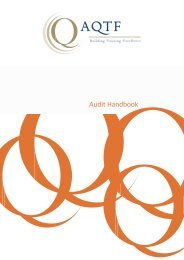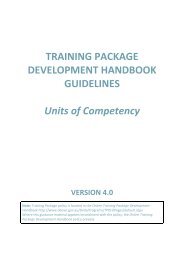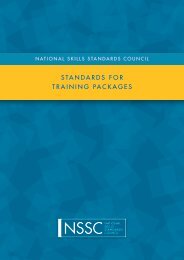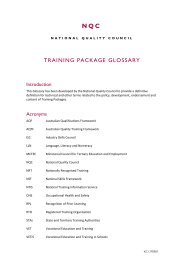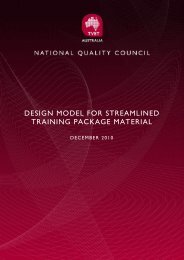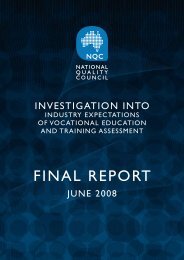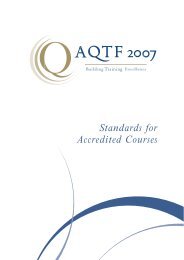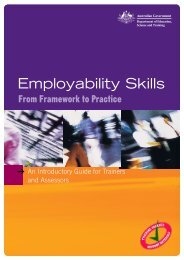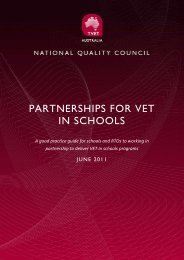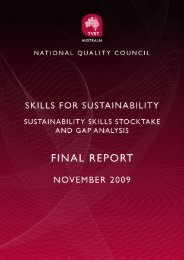VET Products for the 21st Century - National Skills Standards Council
VET Products for the 21st Century - National Skills Standards Council
VET Products for the 21st Century - National Skills Standards Council
You also want an ePaper? Increase the reach of your titles
YUMPU automatically turns print PDFs into web optimized ePapers that Google loves.
Contents<strong>VET</strong> PRODUCTSFOR THE 21 STCENTURYFinal Report of <strong>the</strong> JointSteering Committee of <strong>the</strong>NQC and <strong>the</strong> COAG <strong>Skills</strong>and Work<strong>for</strong>ce DevelopmentSubgroup - June 2009
ContentsLetter from <strong>the</strong> Chair ............................................................................................................................................. 21. Executive Summary .......................................................................................................................................... 31.1 Terms of reference .................................................................................................................................. 31.2 Methodology ............................................................................................................................................ 31.3 Meeting diverse needs ............................................................................................................................ 31.4 Project outcomes ..................................................................................................................................... 41.5 Proposed Policy Framework .................................................................................................................. 41.6 Recommendations .................................................................................................................................. 62. Introduction ....................................................................................................................................................... 82.1 Project & report scope ............................................................................................................................... 82.2 Approach to <strong>the</strong> project ............................................................................................................................. 8 3. Background and context ................................................................................................................................... 9 4. Meeting diverse needs .................................................................................................................................... 10 4.1 Meeting <strong>the</strong> needs of businesses and industry ..................................................................................... 10 4.2 Equipping individuals with broad-based skills and knowledge .............................................................. 10 4.3 Equity considerations ............................................................................................................................ 11 5. Proposed policy framework and recommendations ........................................................................................ 12 5.1 Definition of competency ....................................................................................................................... 14 5.2 Qualifications ......................................................................................................................................... 155.3 Assessment requirements ..................................................................................................................... 165.4 Credit arrangements .............................................................................................................................. 165.5 Language, Literacy and Numeracy ....................................................................................................... 17 5.6 New design <strong>for</strong> Training Packages and Accredited Courses ............................................................... 185.7 Industry engagement and professional practice .................................................................................... 20Appendix A – Consultation List ........................................................................................................................... 21ContactsNQC SecretariatT<strong>VET</strong> AustraliaL21 / 390 St Kilda Road Melbourne VIC 3004Telephone: +61 3 9832 8100Email: nqc.secretariat@tvetaustralia.com.auWeb: www.nqc.tevetaustralia.com.auDisclaimerThis work has been produced on behalf of <strong>the</strong><strong>National</strong> Quality <strong>Council</strong> with funding providedthrough <strong>the</strong> Australian Government Department ofEducation, Employment and Workplace Relationsand state and territory governments. The viewsexpressed herein are not necessarily those of <strong>the</strong>Australian Government or state and territorygovernments.
L e t t e r f r o m t h e C h a i rLetter from <strong>the</strong> ChairJune 2009This report is <strong>the</strong> culmination of more than 12 months of work by a Joint SteeringCommittee of <strong>the</strong> <strong>National</strong> Quality <strong>Council</strong> (NQC) and COAG’s <strong>Skills</strong> and Work<strong>for</strong>ceDevelopment Sub-Group. I acknowledge <strong>the</strong> members of <strong>the</strong> Joint Steering Committeeand in particular its Chair, Ms Megan Lilly, <strong>for</strong> undertaking this significant piece of work. Ialso extend thanks to <strong>the</strong> 500-plus <strong>VET</strong> stakeholders that participated in <strong>the</strong> consultationsand Australia-wide public workshops, which provided <strong>the</strong> Joint Steering Committee anevidence-based foundation <strong>for</strong> its work.The policy framework presented in this report, and its supporting recommendations,indicates broad support <strong>for</strong> <strong>the</strong> key pillars of Australia’s <strong>VET</strong> system: one single nationalsystem, with industry-determined outcomes relevant to work, reflected in nationallyportable qualifications.It does however signal some key areas of re<strong>for</strong>m required to ensure Australian <strong>VET</strong> canaccommodate <strong>the</strong> diverse needs of businesses, industry and individuals, particularly:• The need to revise <strong>the</strong> current definition of ‘competency’ to embody <strong>the</strong> ability totransfer and apply skills and knowledge to new situations and environments.• A restructure and streamlining of Training Packages including separating <strong>the</strong>per<strong>for</strong>mance standards from guidance and supporting in<strong>for</strong>mation. • A full review of packaging rules as applied in Training Packages to ensure maximumflexibility and consistency within and across Training Packages and AccreditedCourses.• Establishment of a joint working group of <strong>the</strong> NQC and <strong>the</strong> Australian QualificationsFramework <strong>Council</strong> (AQFC) to investigate introducing a national credit system.• A stronger focus in <strong>VET</strong> products on preparatory and enabling qualifications, andLanguage, Literacy and Numeracy requirements.The Ministerial <strong>Council</strong> <strong>for</strong> Vocational and Technical Education (MCVTE) has endorsedthis policy framework, subject to three addition recommendations (see page 7) and <strong>the</strong><strong>National</strong> Quality <strong>Council</strong> has established an Action Group to implement its supportingrecommendations.The NQC is committed to ensuring <strong>the</strong> <strong>VET</strong> sector is responsive and adaptable to <strong>the</strong>changing needs of industry, business and individuals and looks <strong>for</strong>ward to overseeing <strong>the</strong>improvements that will flow as <strong>the</strong> new framework is implemented.Patrick McKendryChair, <strong>National</strong> Quality <strong>Council</strong><strong>VET</strong> PRODUCTS FOR THE 21 ST CENTURY - 2
1 . E x e c u t i v e S u m m a r y1. Executive SummaryRecognising synergies between <strong>the</strong> <strong>Council</strong> OfAustralian Governments (COAG) agenda to deliversignificant improvements in human capitaloutcomes <strong>for</strong> all Australians and <strong>the</strong> planned<strong>National</strong> Quality <strong>Council</strong> (NQC) work to identifyimprovements to Training Packages, in mid 2008 aJoint Steering Committee (JSC) of <strong>the</strong> NQC and<strong>the</strong> COAG <strong>Skills</strong> and Work<strong>for</strong>ce Development SubGroup was established to bring <strong>the</strong> work toge<strong>the</strong>r ina joint project called ‘<strong>VET</strong> <strong>Products</strong> <strong>for</strong> <strong>the</strong> <strong>21st</strong><strong>Century</strong>’. This report summarises <strong>the</strong> workconducted by <strong>the</strong> JSC and presents a ProposedPolicy Framework and related recommendations toachieve <strong>the</strong>se objectives.1 . 1 T e r m s o f r e f e r e n c eThe Joint Steering Committee was charged with <strong>the</strong>responsibility of ensuring that nationally recognisedtraining products within <strong>the</strong> <strong>VET</strong> sector are flexibleand responsive to changing industry, business andindividual needs and workplace practices.Improving outcomes <strong>for</strong> clients included work onimproving <strong>the</strong> design of units of competency,Training Packages, <strong>VET</strong> qualifications, accreditedcourses, credit systems and recognitionarrangements to support re<strong>for</strong>ms <strong>for</strong> a more clientand demand driven system. In particular, <strong>the</strong> JSCwas to develop a policy framework to enable <strong>VET</strong>qualifications and products to:• meet <strong>the</strong> needs of businesses and industry; and• equip individuals with broadly based skills andknowledge.1 . 2 M e t h o d o l o g yThe project sought to address issues identified by<strong>the</strong> Joint Steering Committee as fundamental to <strong>the</strong>policy framework <strong>for</strong> <strong>VET</strong> training productsincluding:• <strong>the</strong> way in which competence is currentlydefined and assessed in <strong>the</strong> Australian vocational education and training (<strong>VET</strong>)system;• <strong>the</strong> kinds of qualifications necessary to meet<strong>the</strong> needs of and ensure consistent outcomes<strong>for</strong> <strong>the</strong> diverse groups of learners in <strong>the</strong> <strong>VET</strong>system;• <strong>the</strong> extent to which <strong>the</strong> needs of individualenterprises are being effectively met by <strong>the</strong> current <strong>VET</strong> products;• <strong>the</strong> structure of <strong>National</strong> Training Packages; and• credit systems.The project was completed through a two stageconsultative process. In <strong>the</strong> first stage a draftconsultation paper was developed and <strong>the</strong>n refinedthrough consultation with key peak bodystakeholders. A paper was also commissioned fromNCVER to support <strong>the</strong> consultation process,Competence and competency based training: What<strong>the</strong> literature says 1 and should be read inconjunction with this report.In <strong>the</strong> second stage, feedback on <strong>the</strong> issues andoptions presented in <strong>the</strong> refined consultation paperwas sought from <strong>VET</strong> stakeholders more broadlythrough a second round of targeted consultations,public workshops in each State and Territory and awritten submission process. Pending <strong>the</strong>establishment of <strong>the</strong> equity peak body, <strong>the</strong> <strong>National</strong><strong>VET</strong> Equity Advisory <strong>Council</strong> (NVEAC) acomplementary targeted consultation regardingequity considerations was also undertaken. Inparallel to <strong>the</strong>se consultation processes, a numberof Industry <strong>Skills</strong> <strong>Council</strong>s were invited to conductsome exploratory research to test <strong>the</strong> capacity of<strong>the</strong> current Training Package model to providesolutions to meet <strong>the</strong> training needs of particulargroups of learners.Over 500 people attended public workshops orparticipated in <strong>the</strong> various consultations. It wasalso clear that many of <strong>the</strong> 35 submissionsreceived were from organisations that had<strong>the</strong>mselves consulted o<strong>the</strong>rs, and sometimes quitewidely.1 . 3 M e e t i n g d i v e r s e n e e d sAlthough not identical, <strong>the</strong> JSC sees a convergenceof <strong>the</strong> needs of business, industry and individuals inrelation to boosting participation and productivity.During <strong>the</strong> consultation process, businesses andindustry indicated strong support <strong>for</strong> <strong>the</strong>continuation of Training Packages and accreditedcourses as a single national framework.The increasing flexibility of <strong>the</strong> latest TrainingPackages is also highly valued and accreditedcourses are seen as having <strong>the</strong> capacity to meet<strong>the</strong> needs of niche markets and emerging andconverging industries or technologies. This enablestraining and assessment methodologies to bebetter customised to meet <strong>the</strong> diverse needs ofemployers and individuals. However, <strong>the</strong>re is stillroom <strong>for</strong> improving responsiveness.The JSC acknowledges that literacy, numeracy ando<strong>the</strong>r foundation skills are <strong>the</strong> building blocks of1available at www.nqc.tvetaustralia.com.au<strong>VET</strong> PRODUCTS FOR THE 21 ST CENTURY - 3
human capital and COAG has established <strong>the</strong>literacy and numeracy levels of working age peoplein national and international surveys as anindicative per<strong>for</strong>mance measure. Rapidly changinglabour market demands (including <strong>the</strong> impact ofstructural change in <strong>the</strong> economy and <strong>the</strong> economiccycle) mean that workers will need to be able toadapt to new roles related to <strong>the</strong>ir currentoccupations and rapidly acquire new skills andknowledge to change jobs.Each year, <strong>the</strong> publicly funded <strong>VET</strong> systemprovides programs to over 1.6 million students, <strong>the</strong>vast majority of whom are engaged in <strong>VET</strong> toachieve vocational and labour market outcomes. Itengages with thousands of enterprises to deliver<strong>the</strong>se outcomes. Those 1.6 million <strong>VET</strong> learnersare comprised of a diverse range of groups. Thediversity is likely to grow if participation levels riseconsistent with <strong>the</strong> COAG outcomes.The <strong>VET</strong> system is <strong>the</strong>re<strong>for</strong>e a key mechanism <strong>for</strong>delivering <strong>the</strong> nation’s productivity, work<strong>for</strong>ceparticipation and social inclusion objectives.If <strong>the</strong> <strong>VET</strong> sector is to meet national participationand productivity targets and ensure that it maintainsits strong reputation of making a difference to <strong>the</strong>lives of those who struggle to learn or work, <strong>the</strong>ntraining products and services must be sufficientlyflexible to cater <strong>for</strong> learners whose life experiences,capacities, motivations, resources and need <strong>for</strong>particular educational and o<strong>the</strong>r supports areincredibly diverse, complex and in some cases,expensive.1 . 4 P r o j e c t o u t c o m e sThe outcomes of this project signal unanimoussupport <strong>for</strong> <strong>the</strong> key pillars of Australia’s <strong>VET</strong>system: one single national system, with industrydeterminedoutcomes relevant to work, reflected innationally portable qualifications. The desire topreserve and protect <strong>the</strong>se aspects, and in somecases extend <strong>the</strong>m is very evident.Many feel that change is happening, and realimprovements are being made. Fur<strong>the</strong>r change,<strong>the</strong>y believe, is still needed, while preserving gainsmade to date.1 . 5 P r o p o s e d P o l i c yF r a m e w o r kBased on <strong>the</strong> outcomes of <strong>the</strong> nationalconsultations, <strong>the</strong> Joint Steering Committeeproposes <strong>the</strong> following policy framework to improve<strong>the</strong> flexibility and responsiveness of <strong>the</strong> <strong>VET</strong>system.It should be noted that all of <strong>the</strong> associatedrecommendations have resourcing implications.<strong>VET</strong> PRODUCTS FOR THE 21 ST CENTURY - 4
<strong>VET</strong> PRODUCTS FOR THE 21 ST CENTURY - 5
1 . 6 R e c o m m e n d a t i o n sThat <strong>the</strong> NQC:Recommendation 1Revise <strong>the</strong> definition of competency as follows:Competency is <strong>the</strong> consistentapplication of knowledge and skill to <strong>the</strong>standard of per<strong>for</strong>mance required in <strong>the</strong>workplace. It embodies <strong>the</strong> ability totransfer and apply skills and knowledgeto new situations and environments.Recommendation 2Review supplementary descriptions to incorporate<strong>the</strong> following concepts of competency into <strong>the</strong>definition:• It is demonstrated to <strong>the</strong> standards required in<strong>the</strong> workplace;• It comprises <strong>the</strong> application of specified skillsand knowledge relevant to that occupation;• It makes appropriate reference to required generic and employability skills;• It covers all aspects of workplace per<strong>for</strong>mance; and • It can be demonstrated consistently over time,and covers a sufficient range of experiences(including those in simulated or institutionalenvironments)Recommendation 3Ensure that this definition is used consistently in allkey <strong>VET</strong> documents and Government publications.Recommendation 4Ensure that <strong>the</strong> dimensions of competencyunderpinning <strong>the</strong> definition of competence areexplained more simply and clearly so that <strong>the</strong>y areconceived in ways which meet <strong>the</strong> full range ofneeds of industry, industry sectors, enterprises andindividuals.Recommendation 5Reaffirm a single organising framework <strong>for</strong> <strong>VET</strong>qualifications comprised of Training Packages andAccredited Courses and allow <strong>for</strong> qualifications thatachieve or contribute to occupational outcomes orfoundation skills [i.e., Language, Literacy andNumeracy (LLN) and general education].• packaging rules as applied in Training Packages to ensure maximum flexibility andconsistency within and across Training Packages and Accredited Courses, where both possible and appropriate; • <strong>the</strong> use of units from accredited courses withinTraining Packages; and• <strong>the</strong> process <strong>for</strong> developing and approving Accredited Courses including:- how duplication of training packagecontent and coverage is identified andresolved;- improving consistency between stateaccrediting bodies and across <strong>the</strong> ISCs.The report on <strong>the</strong> outcomes to go to <strong>the</strong> SeptemberCOAG meeting and include detailed changes to beimplemented by <strong>the</strong> NQC as a matter of urgency. 2Recommendation 7Ensure that units of competency are efficientlyutilised within and across industry in order to avoidduplication wherever possible.Recommendation 8Ensure a stronger focus on preparatory andenabling qualifications aimed at building generalwork<strong>for</strong>ce capability and entry to a range of jobs inindustry and occupational areas by explicitlyincorporating such qualifications into <strong>the</strong> nationalframework in a more systematic way.Recommendation 9Ensure that Certificates I and II are clearly identifiedas ei<strong>the</strong>r preparatory or entry-level qualifications.Recommendation 10Allow <strong>for</strong> <strong>VET</strong> qualifications to provide <strong>for</strong> identifiedknowledge and preparatory units of competence asappropriate.Recommendation 11Design and develop <strong>the</strong> specifications <strong>for</strong> <strong>the</strong>proposed endorsed component relating toAssessment Requirements.Recommendation 6In order to maximise consistency, flexibility andresponsiveness, undertake a full andcomprehensive review of:2Refer to page 7 <strong>for</strong> additional resolution from MCVTE<strong>VET</strong> PRODUCTS FOR THE 21 ST CENTURY - 6
Recommendation 12Ensure that <strong>the</strong> context of assessment is clearlyspecified in Training Package Units of Competencywhere <strong>the</strong> industry can make a case <strong>for</strong> each suchtargeted Unit to <strong>the</strong> <strong>National</strong> Quality <strong>Council</strong> at <strong>the</strong>time of Training Package endorsement.Recommendation 13Establish a joint working group of <strong>the</strong> NQC and <strong>the</strong>Australian Qualifications Framework <strong>Council</strong>(AQFC) to investigate introducing a national creditsystem through <strong>the</strong> work on AQFC projects relatedto pathways and streng<strong>the</strong>ning <strong>the</strong> AustralianQualifications Framework.Recommendation 14Ensure that Training Package developers includearticulation arrangements in <strong>the</strong> design anddevelopment of Diploma and Advanced Diplomaswhere appropriate.Recommendation 15Ensure that Language, Literacy and Numeracyrequirements are made more explicit in <strong>the</strong>development of occupational and foundationqualifications.Recommendation 16Simplify and streamline <strong>the</strong> content of TrainingPackages by separating <strong>the</strong> per<strong>for</strong>mance standardsin units of competence from guidance andsupporting in<strong>for</strong>mation <strong>for</strong> RTOs with <strong>the</strong> followingcomponents subject to national endorsement:• Units of competence (required knowledge andskills, i.e., title, elements, per<strong>for</strong>mance criteria,etc)• Qualifications & Occupational/Foundation outcomes• Qualification packaging rules• Assessment Requirements• Credit ArrangementsRecommendation 17Restructure and streamline Training Packagecontent by:• simplifying <strong>the</strong> endorsed components – byreducing <strong>the</strong> level of detail included in <strong>the</strong>endorsed Training Packages, particularly <strong>the</strong> level of specification in <strong>the</strong> competencystandards;• expanding non-endorsed components – muchof <strong>the</strong> detail and specification removed fromendorsed components can instead beincluded in user guides where more flexiblestructural and <strong>for</strong>matting options mean thatmaterial can be edited and packaged in a waythat makes <strong>the</strong>se documents more readableand useable;• eliminating unnecessary in<strong>for</strong>mation and consolidating repetitive material;• continuing to consolidate <strong>the</strong> units ofcompetence that cover <strong>the</strong> same or similar areas of knowledge and skill; and• dividing Packages into more fit-<strong>for</strong>-purposecomponents focused on <strong>the</strong> needs of industryand employers on <strong>the</strong> one hand and providerson <strong>the</strong> o<strong>the</strong>r.Recommendation 18Develop a quality assurance process <strong>for</strong> nonendorsedcomponents of Training Packages.Recommendation 19Reaffirm that course accrediting bodies (RCABs)have <strong>the</strong> capacity to accept/approve courses where<strong>the</strong> outcomes identified by RTOs and enterprisesare not available in endorsed Training Packages.Recommendation 20Make it mandatory <strong>for</strong> crown copyright stateaccredited courses to be publically available on <strong>the</strong>NTIS. 3Recommendation 21Implement <strong>the</strong> proposed recommendations byacknowledging and building on existingprofessional networks and supporting collaborativearrangements between industry and providers inimproving <strong>the</strong> quality of assessment outcomes.MCVTE resolutionsThe Ministerial <strong>Council</strong> <strong>for</strong> Vocational andTechnical Education (MCVTE) endorsed <strong>the</strong> policyframework as outlined in <strong>the</strong> report and agreed to<strong>the</strong> following additional resolutions:• That <strong>the</strong> NQC conduct a review jointly withNVEAC on how best to ensure that equityneeds are addressed in <strong>the</strong> policy framework<strong>for</strong> <strong>VET</strong> <strong>Products</strong> <strong>for</strong> <strong>the</strong> <strong>21st</strong> <strong>Century</strong>.• That in relation to Recommendation 6 <strong>the</strong> outcomes of <strong>the</strong> review will be presented aspart of a high level report to COAG.• That endorsement of Recommendation 20 is subject to scoping of its impact.3Refer to additional resolution from MCVTE<strong>VET</strong> PRODUCTS FOR THE 21 ST CENTURY - 7
2 . I n t r o d u c t i o n2. IntroductionRecognising synergies between <strong>the</strong> <strong>Council</strong> OfAustralian Governments (COAG) agenda to deliversignificant improvements in human capitaloutcomes <strong>for</strong> all Australians and <strong>the</strong> planned<strong>National</strong> Quality <strong>Council</strong> (NQC) work to identifyimprovements to Training Packages, in mid 2008 aJoint Steering Committee (JSC) of <strong>the</strong> NQC and<strong>the</strong> COAG <strong>Skills</strong> and Work<strong>for</strong>ce Development SubGroup was established to bring <strong>the</strong> work toge<strong>the</strong>r ina joint project called ‘<strong>VET</strong> <strong>Products</strong> <strong>for</strong> <strong>the</strong> <strong>21st</strong><strong>Century</strong>’. This report summarises <strong>the</strong> workconducted by <strong>the</strong> JSC and presents a ProposedPolicy Framework and related recommendations toachieve <strong>the</strong>se objectives.2 . 1 P r o j e c t & r e p o r t s c o p eThe JSC was established to develop a policyframework to enable <strong>VET</strong> qualifications andproducts to:• meet <strong>the</strong> needs of businesses and industry;• equip individuals with broadly based skills andknowledge.• provide strategic oversight and guidance of aconsultation project to determine any changesnecessary to <strong>the</strong> definition and design of unitsof competency, Training Packages, <strong>VET</strong>qualifications, accredited courses, creditsystems, and recognition arrangements withinand between systems, to ensure that <strong>the</strong> <strong>VET</strong>sector is able to meet a more demand andclient-driven system;• report to <strong>the</strong> NQC and <strong>the</strong> COAG <strong>Skills</strong> andWork<strong>for</strong>ce Development Subgroup on <strong>the</strong>outcomes of <strong>the</strong> consultation, and provide recommendations; and• facilitate dialogue and collaboration betweenbodies undertaking work in relation to <strong>the</strong> <strong>VET</strong>sector including <strong>the</strong> NQC, COAG, <strong>the</strong>Australian Qualifications Framework <strong>Council</strong>(AQFC) and <strong>Skills</strong> Australia.This report is organised in 5 sections, including anExecutive Summary that outlines <strong>the</strong> principalfindings from <strong>the</strong> project and provides aconsolidated set of recommendations. Section 2provides an introduction to <strong>the</strong> report; Section 3gives <strong>the</strong> background and context; Section 4 dealswith meeting diverse needs and finally Section 5presents <strong>the</strong> proposed policy framework andsupporting recommendations.2 . 2 A p p r o a c h t o t h e p r o j e c tThe project was conducted in two stages. Stage 1was an initial, short consultation process involving18 meetings with key stakeholders in December2008, designed to provide <strong>the</strong> basis <strong>for</strong> broaderstakeholder consultation on options to address<strong>the</strong>se key issues. Stage 2 was a broader andmore comprehensive consultation process. Theconsultations were assisted by a consultation paper(available at www.nqc.tvetaustralia.com.au)covering:• <strong>the</strong> way in which competence is currentlydefined and assessed in <strong>the</strong> Australian vocational education and training (<strong>VET</strong>)system;• <strong>the</strong> kinds of qualifications necessary to meet<strong>the</strong> needs of and ensure consistent outcomes<strong>for</strong> <strong>the</strong> diverse groups of learners in <strong>the</strong> <strong>VET</strong>system;• <strong>the</strong> extent to which <strong>the</strong> needs of individualenterprises are being effectively met by <strong>the</strong> current <strong>VET</strong> products;• <strong>the</strong> structure of <strong>National</strong> Training Packages;• credit systems.Finally, a number of specific consultation questionsand possible options in relation to <strong>the</strong> definition anddevelopment of competency, <strong>VET</strong> qualifications,<strong>the</strong> structure and content of Training Packages andcredit systems were provided <strong>for</strong> consideration. Inaddition, a paper was commissioned from NCVERto support <strong>the</strong> consultation process, Competenceand competency based training: What <strong>the</strong> literaturesay (available at www.nqc.tvetaustralia.com.au), tobe read in conjunction with <strong>the</strong> consultation paper.In January 2009, a consortium of NCVER/IthacaGroup was contracted to:• Co-ordinate, conduct and manageconsultations (see Appendix A <strong>for</strong> details ofconsultations conducted) based on an agreedmethodology• Collate and evaluate consultation outcomes• Prepare a final report (with advice on possiblerecommendations) based on an analysis of:- <strong>the</strong> outcomes of <strong>the</strong> consultationsconducted;- a syn<strong>the</strong>sis of <strong>the</strong> outcomes from six (6)ISC research sub-projects and o<strong>the</strong>rrelated NQC projects.An electronic public submission process was alsoestablished to allow those who could not attend apublic workshop to provide <strong>the</strong>ir views and a total of35 submissions were received and acomplementary targeted consultation regardingequity considerations was undertaken (seeAppendix B <strong>for</strong> stakeholders interviewed). Over 500people attended public workshops or participated in<strong>the</strong> various consultations. It was also clear thatmany of <strong>the</strong> submissions received were fromorganisations that had <strong>the</strong>mselves consultedo<strong>the</strong>rs, and sometimes quite widely.<strong>VET</strong> PRODUCTS FOR THE 21 ST CENTURY - 8
3 . B a c k g r o u n d a n d c o n t e x t3. Background and contextAt its meeting in March 2008 <strong>the</strong> <strong>Council</strong> ofAustralian Governments (COAG) agreed to a policyframework in <strong>the</strong> areas of skills and work<strong>for</strong>cedevelopment which is designed to boost Australia’sparticipation and productivity. The policyframework identifies four key outcomes:1. The working age population have gaps infoundation skills levels reduced to enableeffective educational, labour market and socialparticipation;2. The working age population has <strong>the</strong> depth andbreadth of skills and capabilities required <strong>for</strong> <strong>the</strong><strong>21st</strong> century labour market;3. The supply of skills provided by <strong>the</strong> nationaltraining system responds to meet changinglabour market demand; and4. <strong>Skills</strong> are used effectively to increase labourmarket efficiency, productivity, innovation, andensure increased utilisation of human capital.To deliver <strong>the</strong>se outcomes <strong>the</strong> vocational educationand training (<strong>VET</strong>) sector needs to engage people,both in and out of <strong>the</strong> work<strong>for</strong>ce, who requirefoundation skills; stimulate demand from individualsand businesses <strong>for</strong> higher level nationallyaccredited training; and enable providers torespond to <strong>the</strong> differing needs of individuals,businesses and industry. The capability andcapacity of <strong>the</strong> <strong>VET</strong> sector is <strong>the</strong>re<strong>for</strong>e critical. Toachieve <strong>the</strong>se outcomes, COAG identified six policyand re<strong>for</strong>m directions:1. Re<strong>for</strong>ming training products, services,in<strong>for</strong>mation systems and regulation to meet amore demand and client driven system;2. Driving fur<strong>the</strong>r competition in current trainingarrangements and streng<strong>the</strong>ning capacity ofproviders and businesses to build <strong>the</strong>foundation and deeper and broader skillsrequired by <strong>the</strong> <strong>21st</strong> century labour market;3. Creating an investment environment andsettings that optimises investment from allsources (governments, individuals, businessesand industry) including funding <strong>for</strong> delivery, taxpolicy, employment programs and incentives;4. Renewal of governance framework to rein<strong>for</strong>ce<strong>the</strong> role of industry and maximise effectivenessand efficiency in intergovernmental relations;5. Ensuring that skills are fully utilised andwastage of human capital is reduced; and6. Identify barriers and implement changes neededin <strong>the</strong> structure and operation of <strong>the</strong> trainingsystem (both nationally and locally) to improvequalification completions and participation inhigher level qualifications by IndigenousAustralians.The JSC recognises that Australia’s <strong>VET</strong> systemhas a role to play in boosting Australia’sparticipation and productivity. In particular, <strong>the</strong> <strong>VET</strong>system will be critical in achieving COAG targetsrelated to an increased:• proportion of <strong>the</strong> working age population at literacy level 1, 2 and 3 (in <strong>the</strong> Adult Literacyand Life <strong>Skills</strong> Survey 4 ); • proportion of 20-64 year olds who have a qualification at or above Certificate III (with a target to halve <strong>the</strong> proportion of 20-64 year olds without qualifications at Certificate III level by 2020, and to double <strong>the</strong> number ofhigher qualification completions by 2020Notably, <strong>the</strong> Commonwealth Government’sresponse to <strong>the</strong> Review of Australian HigherEducation (Bradley Review) sets new targets of (i)40 percent of all 25-34 year olds with a qualificationat bachelor level or above by 2025; and (ii) 20percent of higher education enrolments atundergraduate level should be of people from lowsocio-economic backgrounds by 2020; andexplicitly acknowledges a key role <strong>for</strong> <strong>VET</strong> inachieving <strong>the</strong>se targets. 5The <strong>National</strong> Quality <strong>Council</strong>’s (NQC) 2008 WorkPlan included a project designed to develop policydirections in relation to <strong>the</strong> next generation ofTraining Packages, including a broad consultativeprocess. This project was to build on researchconducted on behalf of <strong>the</strong> NQC in 2007 andadvice provided to MCTVE in 2006 that‘consideration be given to’ ‘providing greaterflexibility and adaptability within <strong>the</strong> next generationof Training Packages’ and ‘building on <strong>the</strong> currentcompetency approach by incorporating <strong>the</strong>development of personal capabilities and attributes(e.g. employability skills) and placing greateremphasis on cognitive ra<strong>the</strong>r than functional(technical) skills’.This project <strong>the</strong>re<strong>for</strong>e represents a convergence of<strong>the</strong> COAG work<strong>for</strong>ce participation and productivityagenda and NQC work to identify improvements toTraining Packages and nationally recognisedvocational education and training (<strong>VET</strong>)qualifications.4Adult Literacy and Life <strong>Skills</strong> Survey, Summary Results,ABS, 20065from <strong>the</strong> Deputy Prime Minister’s speeches of 4, 5, 9 March2009<strong>VET</strong> PRODUCTS FOR THE 21 ST CENTURY - 9
4 . M e e t i n g d i v e r s e n e e d s4. Meeting diverse needsAlthough not identical, <strong>the</strong> JSC sees a convergenceof <strong>the</strong> needs of business, industry and individuals inrelation to boosting participation and productivity.4 . 1 M e e t i n g t h e n e e d s o fb u s i n e s s e s a n d i n d u s t r yDuring <strong>the</strong> consultation process, businesses andindustry indicated strong support <strong>for</strong> <strong>the</strong>continuation of Training Packages and accreditedcourses as a single national framework.The increasing flexibility of <strong>the</strong> latest TrainingPackages is also highly valued. This is perceived toenable training and assessment methodologies tobe better customised to meet <strong>the</strong> diverse needs ofemployers and individuals. However, <strong>the</strong>re is stillroom <strong>for</strong> improving responsiveness and <strong>the</strong>proposed policy framework <strong>the</strong>re<strong>for</strong>e needs to buildon <strong>the</strong> strengths of <strong>the</strong> existing system by ensuringmore flexible packaging rules <strong>for</strong> Training Packagequalifications and accredited courses to meetindustry needs. This, toge<strong>the</strong>r with improvedTraining Package development and endorsementand continuous improvement processes will ensuregreater responsiveness to leading edge industrypractice.Accredited courses are seen as having <strong>the</strong> capacityto meet <strong>the</strong> needs of niche markets and emergingand converging industries or technologies. Inaddition, <strong>the</strong>y address changes in skill needs in aresponsive manner and also provide a mechanism<strong>for</strong> meeting <strong>the</strong> needs of special groups, especiallythose with Language, Literacy and Numeracyissues.4 . 2 E q u i p p i n g i n d i v i d u a l sw i t h b r o a d - b a s e d s k i l l s a n dk n o w l e d g eThe JSC acknowledges that literacy, numeracy ando<strong>the</strong>r foundation skills are <strong>the</strong> building blocks ofhuman capital and COAG has established <strong>the</strong>literacy and numeracy levels of working age peoplein national and international surveys as anindicative per<strong>for</strong>mance measure. The work<strong>for</strong>ce willrequire both deeper and broader skills in <strong>the</strong> futuredue to <strong>the</strong> impacts of globalisation, structuralchange in <strong>the</strong> labour market and <strong>the</strong> economy,technological change, work<strong>for</strong>ce aging (meaningthat workers will need to participate in <strong>the</strong>work<strong>for</strong>ce <strong>for</strong> longer), changing consumerpreferences, quality assurance and compliancerequirements and <strong>the</strong> need to produce goods andprovide services in a more environmentallysustainable manner 6 .Rapidly changing labour market demands(including <strong>the</strong> impact of structural change in <strong>the</strong>economy and <strong>the</strong> economic cycle) mean thatworkers will need to be able to adapt to new rolesrelated to <strong>the</strong>ir current occupations and rapidlyacquire new skills and knowledge to change jobs.Each year, <strong>the</strong> publicly funded <strong>VET</strong> systemprovides programs to over 1.6 million students, <strong>the</strong>vast majority of whom are engaged in <strong>VET</strong> toachieve vocational and labour market outcomes. Itengages with thousands of enterprises to deliver<strong>the</strong>se outcomes. Those 1.6 million <strong>VET</strong> learnersare comprised of a diverse range of groups. Thediversity is likely to grow if participation levels riseconsistent with <strong>the</strong> COAG outcomes. Thesegroups include:• students requiring foundation skills;• students undertaking <strong>VET</strong> in schools ando<strong>the</strong>r full time learners in preparatoryprograms;• apprentices and trainees;• new entrants to <strong>the</strong> work<strong>for</strong>ce and those seeking to return to <strong>the</strong> work<strong>for</strong>ce;• existing workers including:- those with gaps in foundation skills;- those undertaking training related to <strong>the</strong>ir work;- those wishing to change careersunrelated to <strong>the</strong>ir current work;- those facing unemployment orsignificant change to <strong>the</strong>ir workstructure;- casual and part time workers who havelimited access to work-based learningparticularly those only working on anintermittent basis.• students wishing to articulate to Higher Education;• higher education students moving to <strong>VET</strong>; and• international students (both onshore and offshore). Across each of <strong>the</strong>se groups <strong>the</strong>re are somestudents who also have specific learning needs andrequirements such as students with disabilities.Similarly, many indigenous students have bothspecific learning needs and may require trainingwhich is organised and delivered in a way which isconsistent with cultural and community needs.6 See DEEWR 2006 Overview Analysis on Industry <strong>Skills</strong>Reports<strong>VET</strong> PRODUCTS FOR THE 21 ST CENTURY - 10
Students in remote localities face particularchallenges in being able to access training andworkplaces. There is also an important and growinginterface between <strong>for</strong>mal <strong>VET</strong> and communitybasededucation and training providers.It should be recognised that regardless of <strong>the</strong>irlearning pathway, <strong>the</strong> vast majority of students areengaged in <strong>VET</strong> <strong>for</strong> vocational and work relatedpurposes. However, some people work in <strong>the</strong>occupations <strong>for</strong> which <strong>the</strong>y have not trained ando<strong>the</strong>rs work in occupations <strong>for</strong> which <strong>the</strong>y do nothave relevant <strong>for</strong>mal qualifications 7 . This suggeststhat <strong>the</strong> ability to learn ‘on <strong>the</strong> job’ and <strong>the</strong> capacityto adapt to new job roles and circumstances isimportant <strong>for</strong> individuals and <strong>the</strong> work<strong>for</strong>cegenerally.These imperatives suggest <strong>the</strong> following threemajor roles <strong>for</strong> <strong>VET</strong> in assisting to meet <strong>the</strong> COAGoutcomes:• building sound foundation skills, in particularliteracy and numeracy at levels required <strong>for</strong>effective participation in <strong>the</strong> work<strong>for</strong>ce and <strong>for</strong>fur<strong>the</strong>r learning;• developing technical and occupational skillsrequired <strong>for</strong> specific jobs; and• developing <strong>the</strong> wider range of broadercapabilities required <strong>for</strong> specific jobs and <strong>the</strong>capacity to take on new roles and jobs as <strong>the</strong>labour market changes.It is <strong>the</strong>re<strong>for</strong>e proposed that <strong>the</strong> definition ofcompetence be revised to make explicit <strong>the</strong> factthat competence needs to embody <strong>the</strong> ability totransfer and apply skills and knowledge to newsituations and environments and that <strong>VET</strong>qualifications allow <strong>for</strong> both occupational andfoundation skills outcomes.4 . 3 E q u i t y c o n s i d e r a t i o n sThe <strong>VET</strong> system is a key mechanism <strong>for</strong> delivering<strong>the</strong> nation’s productivity, work<strong>for</strong>ce participationand social inclusion objectives. Yet, <strong>the</strong> <strong>National</strong><strong>VET</strong> Advisory Alliance in its final report to Ministers(2008) noted that:Annual <strong>National</strong> Report per<strong>for</strong>mancemeasures (2006) <strong>for</strong> female students,people with a disability, those with alanguage background o<strong>the</strong>r than Englishand Indigenous students, indicate a lackof progress particularly <strong>for</strong> Indigenousstudents and students with disabilities in<strong>the</strong> <strong>VET</strong> system. 8Additionally, <strong>the</strong>y advised that:• Over a four-year period (2003-2006), relative to all students, <strong>the</strong>re had been little improvement in <strong>the</strong> proportion of students in <strong>the</strong> four equity groups participating in <strong>VET</strong>.• Over <strong>the</strong> four-year period, <strong>the</strong>re had only beena marginal increase in <strong>the</strong> load pass rate <strong>for</strong>Indigenous students, students with a disabilityand people who speak a language o<strong>the</strong>r thanEnglish at home. Women’s load pass ratesare at <strong>the</strong> same level as <strong>the</strong> overall <strong>VET</strong>student population.• In 2006, people with a disability were muchless likely than any o<strong>the</strong>r student group to bestudying at Certificate III and above courselevels. Indigenous students were alsounderrepresented at <strong>the</strong>se levels and overrepresentedat Certificate I and II or non AQTFlevels. This is of concern since Certificate Iand II level and non-AQTF level courses areless likely to lead to employment.• While <strong>the</strong>re had been a decline in fur<strong>the</strong>rstudy and employment outcomes <strong>for</strong> all <strong>VET</strong>students over <strong>the</strong> four-year period, <strong>the</strong> declineis much worse <strong>for</strong> <strong>the</strong> four equity groups. ForIndigenous Australians and people with adisability who in 2006 were 14% and 22%respectively below o<strong>the</strong>r students inemployment outcomes, <strong>the</strong> falling trend over 4years is of major concern. 9In <strong>the</strong> face of <strong>the</strong>se per<strong>for</strong>mance outcomes, it iscritical that a revitalised policy framework <strong>for</strong> <strong>VET</strong><strong>Products</strong> <strong>for</strong> <strong>the</strong> 21 st <strong>Century</strong> caters <strong>for</strong> <strong>the</strong> diversityof learners it must engage, if <strong>the</strong> <strong>VET</strong> sector is tomeet national participation and productivity targetsand ensure that it maintains its strong reputation ofmaking a difference to <strong>the</strong> lives of those whostruggle to learn or work. In particular, trainingproducts and services of <strong>the</strong> <strong>VET</strong> sector must besufficiently flexible to cater <strong>for</strong> learners whose lifeexperiences, capacities, motivations, resources andneed <strong>for</strong> particular educational and o<strong>the</strong>r supportsare incredibly diverse, complex and in some cases,expensive.Given <strong>the</strong> <strong>VET</strong> system’s central role in meetingequity inclusivity goals and <strong>the</strong> imminentestablishment of <strong>the</strong> <strong>National</strong> <strong>VET</strong> Equity Advisory<strong>Council</strong> (NVEAC), it will be critical <strong>for</strong> <strong>the</strong> NQC andNVEAC to jointly conduct a review on how best toensure that equity needs are addressed.7The 2008 student outcomes data from NCVER indicatesthat ‘Overall, 30.3% of graduates were employed in <strong>the</strong> sameoccupation group as <strong>the</strong>ir training course. Ano<strong>the</strong>r 33.8%were employed in o<strong>the</strong>r occupations but found <strong>the</strong>ir trainingrelevant. 16.8% were employed in o<strong>the</strong>r occupations andfound <strong>the</strong>ir training not relevant to <strong>the</strong>ir current job’.8<strong>National</strong> <strong>VET</strong> Advisory Alliance final report, unpublished, p49<strong>National</strong> <strong>VET</strong> Advisory Alliance final report, unpublished, p5<strong>VET</strong> PRODUCTS FOR THE 21 ST CENTURY - 11
5 . P r o p o s e d p o l i c y f r a m e w o r k a n d r e c o m m e n d a t i o n s5 . P r o p o s e d p o l i c y f r a m e w o r k a n d r e c o m m e n d a t i o n s5. Proposed policy framework and recommendationsOver <strong>the</strong> past two decades, <strong>the</strong>re have beensignificant re<strong>for</strong>ms to <strong>VET</strong> courses, providers andsystems to develop a national training system. Akey re<strong>for</strong>m has been <strong>the</strong> development of nationalindustry competency standards to define industrycompetency requirements <strong>for</strong> <strong>the</strong> occupationscovered by <strong>the</strong> <strong>VET</strong> sector. Training Packages(introduced in 1997), have provided a mechanism<strong>for</strong> directly linking qualifications and standards andensuring that outcomes from qualifications meet<strong>the</strong>se standards.In relation to <strong>the</strong> COAG outcomes, <strong>the</strong>re are twothreshold issues that must be addressed inconsidering any revised policy framework <strong>for</strong>national <strong>VET</strong> products, <strong>the</strong> extent to which <strong>the</strong>:• current approach to defining, developing andassessing competence in Australia is sufficientto help achieve <strong>the</strong> COAG outcomes; and• current suite of <strong>VET</strong> qualifications specifiedthrough <strong>National</strong> Training Packages arerelevant to <strong>the</strong> needs, circumstances andintentions of <strong>the</strong> diverse groups of <strong>VET</strong>learners, can be consistently and reliablyassessed in terms of workplace competence,and can also meet <strong>the</strong> diverse needs ofindividual enterprises.Along with <strong>the</strong>se threshold issues, previous workundertaken by <strong>the</strong> NQC highlights <strong>the</strong> need <strong>for</strong>consideration of issues relating to <strong>the</strong> structure andcontent of Training Packages as <strong>the</strong>y have evolvedover <strong>the</strong> last ten years.The outcomes of this project signal unanimoussupport <strong>for</strong> <strong>the</strong> key pillars of Australia’s <strong>VET</strong>system: one single national system, with industrydeterminedoutcomes relevant to work, reflected innationally portable qualifications. The desire topreserve and protect <strong>the</strong>se aspects, and in somecases extend <strong>the</strong>m is very evident.Many feel that change is happening, and realimprovements are being made. Fur<strong>the</strong>r change,<strong>the</strong>y believe, is still needed, while preserving gainsmade to date.A number of concerns regarding <strong>the</strong> capability of<strong>the</strong> <strong>VET</strong> work<strong>for</strong>ce also emerged. While this isbeyond <strong>the</strong> terms of reference <strong>for</strong> <strong>the</strong> JSC , this isseen as an important consideration in ensuring <strong>the</strong>consistent application and interpretation of <strong>VET</strong>policies, concepts, and requirements (especially butnot limited to Training Package packaging rules)and it concerns all key players (including trainers,assessors, auditors, and training packagedevelopers). This will become more critical given anageing and increasingly casualised <strong>VET</strong> work<strong>for</strong>ce.Based on <strong>the</strong> outcomes of <strong>the</strong> nationalconsultations, <strong>the</strong> Joint Steering Committeeproposes <strong>the</strong> following policy framework to improve<strong>the</strong> flexibility and responsiveness of <strong>the</strong> <strong>VET</strong>system. It should be noted that all of <strong>the</strong>associated recommendations have resourcingimplications.<strong>VET</strong> PRODUCTS FOR THE 21 ST CENTURY - 12
<strong>VET</strong> PRODUCTS FOR THE 21 ST CENTURY - 13
5 . 1 D e f i n i t i o n o f c o m p e t e n c yThe current definition of ‘competency’ within <strong>the</strong>Australian <strong>VET</strong> system emphasises <strong>the</strong> importanceof workplace experience in terms of <strong>the</strong>demonstration of competence. Competencystandards were first introduced to provide abenchmark against which states and territoriescould accredit courses and qualifications, however,with <strong>the</strong> introduction of Training Packagescompetency standards are now directly aligned withnational qualifications.The primary focus of competency standards inAustralia is <strong>the</strong>re<strong>for</strong>e <strong>the</strong> on <strong>the</strong> achievement ofper<strong>for</strong>mance standards required <strong>for</strong> specificoccupations. Each unit of competency must alsoembed employability skills relevant to <strong>the</strong> unit andcontain explicit language, literacy and numeracyrequirements relevant to <strong>the</strong> unit, however, <strong>the</strong>sereflect but must not exceed <strong>the</strong> work requirements<strong>for</strong> <strong>the</strong> unit. Similarly, knowledge requirements in<strong>the</strong> unit of competency must be derived from <strong>the</strong>requirements of <strong>the</strong> work task.The consultations indicated that <strong>the</strong>re is nosignificant pressure to alter <strong>the</strong> current definition ofcompetency in a major way, although <strong>the</strong>re iscommon agreement to clarify <strong>the</strong> scope and that<strong>the</strong> explanation that underpins <strong>the</strong> definition can beimproved by simplifying, and streng<strong>the</strong>ning itsmeaning.Multiple definitions of competency appear in key<strong>VET</strong> policies and documents, which may inhibit <strong>the</strong>development of a uni<strong>for</strong>m understanding ofcompetency, and need to be made consistent.There is also support <strong>for</strong> developing or improvingdocumentation that explains what is meant by <strong>the</strong>different elements in <strong>the</strong> definition.A key issue in addressing <strong>the</strong> COAG outcomes is<strong>the</strong> extent to which <strong>the</strong> focus of <strong>the</strong> Australian <strong>VET</strong>system on occupational competence is sufficient tobuild <strong>the</strong> levels of foundation skills and <strong>the</strong> deeperand broader attributes and capabilities required <strong>for</strong><strong>the</strong> 21 st century work<strong>for</strong>ce and to meet changinglabour market demand. The JSC recommends <strong>the</strong>following actions be taken to assist in meeting<strong>the</strong>se outcomes.RecommendationsThat <strong>the</strong> NQC:1. Revise <strong>the</strong> definition of ‘competency’ as follows:Competency is <strong>the</strong> consistent application of knowledge and skill to <strong>the</strong> standard ofper<strong>for</strong>mance required in <strong>the</strong> workplace. It embodies <strong>the</strong> ability to transfer and applyskills and knowledge to new situations and environments.2. Review supplementary descriptions to incorporate <strong>the</strong> following concepts of competency into <strong>the</strong> definition:• It is demonstrated to <strong>the</strong> standards required in <strong>the</strong> workplace;• It comprises <strong>the</strong> application of specified skills and knowledge relevant to that occupation;• It makes appropriate reference to required generic and employability skills;• It covers all aspects of workplace per<strong>for</strong>mance; and• It can be demonstrated consistently over time, and covers a sufficient range of experiences (includingthose in simulated or institutional environments)3. Ensure that this definition is used consistently in all key <strong>VET</strong> documents and Government publications.4. Ensure that <strong>the</strong> dimensions of competency underpinning <strong>the</strong> definition of competence are explained moresimply and clearly so that <strong>the</strong>y are conceived in ways which meet <strong>the</strong> full range of needs of industry,industry sectors, enterprises and individuals.<strong>VET</strong> PRODUCTS FOR THE 21 ST CENTURY - 14
5 . 2 Q u a l i f i c a t i o n sThe consultations revealed overwhelming support<strong>for</strong> retaining Training Packages and AccreditedCourses as <strong>the</strong> single organising framework <strong>for</strong>qualifications in <strong>the</strong> <strong>VET</strong> system. There was,however, a desire <strong>for</strong> packaging rules to beharmonised as much as possible and to allow <strong>for</strong><strong>the</strong> widest choice of elective units from within andacross Packages and from accredited courseswhere appropriate. There is a strong commitmentto allowing enough flexibility in qualificationstructures to ensure that one single industrydefinedsystem meets all needs. The differingnature of industries, from traditional trades (oftenhighly regulated) to newer or unregulated industriesin which <strong>the</strong> requirements are more difficult todefine, was also recognised, but it was felt <strong>the</strong>sedifferent needs should be addressed within a singlecohesive system. There is also support <strong>for</strong>ensuring a stronger focus on preparatory andenabling qualifications aimed at building generalwork<strong>for</strong>ce capability and entry to a range of jobs inindustry and occupational areas. This could beachieved by explicitly incorporating suchqualifications into <strong>the</strong> national framework in a moresystematic way.Consultations with industry groups and withproviders also highlighted <strong>the</strong> importance ofunderpinning knowledge or <strong>the</strong>ory in <strong>the</strong>development of competence, noting that this isespecially true <strong>for</strong> qualifications which require highlevels of knowledge and <strong>the</strong>ory to underpincompetency. Many of those consulted believed that<strong>the</strong> knowledge components of units of competencydo not receive enough attention in training. Thekey issue appears to be <strong>the</strong> extent to which <strong>the</strong>knowledge requirements are made explicit inTraining Packages. While some Training Packagesexpress <strong>the</strong> knowledge component effectively at<strong>the</strong> unit level, o<strong>the</strong>rs do not identify it as clearly.Consultations did not address whe<strong>the</strong>r <strong>the</strong>knowledge components are comprehensive andsufficiently <strong>for</strong>ward-looking and this will requirefur<strong>the</strong>r investigation during <strong>the</strong> design anddevelopment phase. There is overwhelmingsupport however, <strong>for</strong> knowledge to be presentedclearly and in a <strong>for</strong>m within <strong>the</strong> unit and/orqualification that its importance is recognised byRTOs, funders and o<strong>the</strong>r stakeholders.RecommendationsThat <strong>the</strong> NQC:5. Reaffirm a single organising framework <strong>for</strong> <strong>VET</strong> qualifications comprised of Training Packages andAccredited Courses and allow <strong>for</strong> qualifications that achieve or contribute to occupational outcomes orfoundation skills [i.e., Language, Literacy and Numeracy (LLN) and general education].6. In order to maximise consistency, flexibility and responsiveness, undertake a full and comprehensivereview of:• packaging rules as applied in Training Packages to ensure maximum flexibility and consistency withinand across Training Packages and Accredited Courses, where both possible and appropriate;• <strong>the</strong> use of units from accredited courses within Training Packages; and• <strong>the</strong> process <strong>for</strong> developing and approving Accredited Courses including:- how duplication of training package content and coverage is identified and resolved;- improving consistency between state accrediting bodies and across <strong>the</strong> ISCs.The report on <strong>the</strong> outcomes to go to <strong>the</strong> September COAG meeting and include detailed changes to beimplemented by <strong>the</strong> NQC as a matter of urgency. 107. Ensure that units of competency are efficiently utilised within and across industry in order to avoidduplication wherever possible.8. Ensure a stronger focus on preparatory and enabling qualifications aimed at building general work<strong>for</strong>cecapability and entry to a range of jobs in industry and occupational areas by explicitly incorporating suchqualifications into <strong>the</strong> national framework in a more systematic way.9. Ensure that Certificates I and II are clearly identified as ei<strong>the</strong>r preparatory or entry-level qualifications.10. Allow <strong>VET</strong> qualifications to provide <strong>for</strong> identified knowledge and preparatory units of competency asappropriate.10Refer to page 9 <strong>for</strong> additional resolution from MCVTE<strong>VET</strong> PRODUCTS FOR THE 21 ST CENTURY - 15
5 . 3 A s s e s s m e n t r e q u i r e m e n t sThe combination of defining competency as ‘<strong>the</strong>ability to per<strong>for</strong>m particular tasks and duties to <strong>the</strong>standard of per<strong>for</strong>mance expected in <strong>the</strong>workplace’ coupled with <strong>the</strong> requirement <strong>for</strong> eachTraining Package qualification to have ‘a distinctoccupational outcome’, presents challenges <strong>for</strong> <strong>the</strong><strong>VET</strong> sector in meeting <strong>the</strong> needs of <strong>the</strong> diversegroup of learners identified. For example:• There can be limited capacity to acquire and have competence assessed <strong>for</strong> those studentspreparing <strong>for</strong> entry to <strong>the</strong> work<strong>for</strong>ce and <strong>for</strong> fur<strong>the</strong>r learning and returning to study as <strong>the</strong>ymay not be in <strong>the</strong> work<strong>for</strong>ce;• Many international students may be disadvantaged due to employment opportunities and/or visa requirements;• Many <strong>VET</strong> learners in work are employed in occupations that may not be relevant to <strong>the</strong>irareas of training; • Students undertaking programs to articulate to Higher Education may not be seeking aspecific occupational outcome from <strong>VET</strong>; and• Different <strong>VET</strong> learners enrolled in <strong>the</strong> same qualification may have significantly different levels of experience in <strong>the</strong> workplace.Challenges such as <strong>the</strong>se, relating to <strong>the</strong> access of<strong>VET</strong> learners to a relevant workplace, are likely tointensify as <strong>the</strong> economy turns down and <strong>the</strong> labourmarket contracts.The consultations rein<strong>for</strong>ced <strong>the</strong> need <strong>for</strong> clearerdirection on <strong>the</strong> contexts in which competence canbe demonstrated. Some must be demonstrated in aworkplace context, whilst o<strong>the</strong>rs may best bedemonstrated in simulated environments orassessed in o<strong>the</strong>r ways. Some of those consultedpointed out that <strong>the</strong> nature of some workplacesmeant that, even <strong>the</strong>re, it was difficult todemonstrate <strong>the</strong> full dimensions of competence. Awide range of assessment approaches is needed toassess <strong>the</strong> understandings that underpin workplacebehaviour and per<strong>for</strong>mance in a range ofoccupational areas, while o<strong>the</strong>r areas are moreskills-oriented.As a result, <strong>the</strong> JSC recommend that <strong>the</strong> context ofassessment be clearly specified in TrainingPackage units of competency, especially where <strong>the</strong>industry can identify and demonstrate that <strong>the</strong>re arekey risks in deeming someone as competent toper<strong>for</strong>m in a workplace environment when <strong>the</strong>yhave not been assessed in one. The JSCrecommends that industry must make a case <strong>for</strong>this to <strong>the</strong> <strong>National</strong> Quality <strong>Council</strong> at <strong>the</strong> time ofTraining Package endorsement.RecommendationsThat <strong>the</strong> NQC:11. Design and develop <strong>the</strong> specifications <strong>for</strong> <strong>the</strong> proposed endorsed component relating to AssessmentRequirements.12. Ensure that <strong>the</strong> context of assessment is clearly specified in Training Package units of competency where<strong>the</strong> industry can make a case <strong>for</strong> each such targeted Unit to <strong>the</strong> <strong>National</strong> Quality <strong>Council</strong> at <strong>the</strong> time ofTraining Package endorsement.5 . 4 C r e d i t a r r a n g e m e n t sThe extent to which current arrangements <strong>for</strong>recognition of current competence are effective hasbeen <strong>the</strong> subject of considerable debate inAustralia in recent years. Credit systems havebeen, or are being, developed in a number ofcountries to <strong>for</strong>malise credit arrangements or make<strong>the</strong>m more consistent and transparent, and to allowindividuals to accumulate credit at <strong>the</strong> unit ormodule level towards full qualifications. Theytypically achieve this by assigning value to units ormodules in terms of <strong>the</strong>ir level of complexity and<strong>the</strong> amount of learning involved acrossqualifications frameworks.<strong>VET</strong> PRODUCTS FOR THE 21 ST CENTURY - 16
There are mixed views about whe<strong>the</strong>r or not to staywith <strong>the</strong> status quo or to introduce a nationalsystem. It is generally agreed that <strong>the</strong>re is a needto streng<strong>the</strong>n national approaches to credit transferand articulation between <strong>the</strong> <strong>VET</strong> and HigherEducation sector, but less agreement on. how thisshould occur. The consultations found that <strong>the</strong>re islittle support <strong>for</strong> complex and administrativelyburdensome credit arrangements, however <strong>the</strong>re isstrong support <strong>for</strong> developing a simple, nationallyconsistent approach to credit transfer andarticulation.Given that <strong>the</strong> Australian Qualifications Framework<strong>Council</strong> (AQFC) is currently working to <strong>the</strong> DeputyPrime Minister’s brief ‘to improve articulation andconnectivity between <strong>the</strong> university and <strong>the</strong> <strong>VET</strong>sectors to enable competency-based and meritbasedsystems to become student focussed’ and<strong>the</strong> critical <strong>VET</strong> expertise in this area that can beoffered by <strong>the</strong> NQC. The JSC recommends that ajoint working group of <strong>the</strong> AQFC and <strong>the</strong> NQC be<strong>for</strong>med to progress work on <strong>the</strong> AQFC projectsrelated to pathways and streng<strong>the</strong>ning <strong>the</strong>Australian Qualifications Framework.In <strong>the</strong> meantime <strong>the</strong> JSC recommends taking a ‘fit<strong>for</strong> purpose’ approach during <strong>the</strong> design anddevelopment of Diplomas and Advanced Diplomasto include articulation arrangements whereappropriate.RecommendationsThat <strong>the</strong> NQC:13. Establish a joint working group of <strong>the</strong> NQC and <strong>the</strong> Australian Qualifications Framework <strong>Council</strong> (AQFC) toinvestigate introducing a national credit system through <strong>the</strong> work on AQFC projects related to pathwaysand streng<strong>the</strong>ning <strong>the</strong> Australian Qualifications Framework.14. Ensure that Training Package developers include articulation arrangements in <strong>the</strong> design and developmentof Diploma and Advanced Diplomas where appropriate.5 . 5 L a n g u a g e , L i t e r a c y a n d N u m e r a c yThe consultation acknowledged that <strong>the</strong>re are arange of arrangements <strong>for</strong> addressing <strong>the</strong> needsof learners with low level basic language, literacyand numeracy (LLN) skills (including <strong>the</strong>Australian Core <strong>Skills</strong> Framework, and AdultBasic Education qualifications). LLN peakbodies, practitioners and administratorsemphasised however, <strong>the</strong> importance of having<strong>the</strong>se arrangements located under <strong>the</strong> umbrellaof <strong>the</strong> national framework and integrated intoTraining Packages <strong>the</strong>mselves.It was also felt that <strong>the</strong> exclusive use ofaccredited courses to deliver stand alone LLNtraining would decrease <strong>the</strong> status and value ofLLN provision. Many feel that <strong>the</strong> development ofLLN skills needs to be grounded in learning thathas a purpose, such as vocational learning,ra<strong>the</strong>r than solely in general programs. LLNshould not just be considered as purelypreparation <strong>for</strong> entry-level programs, but also asa component of <strong>the</strong> continuing cognitivedevelopment associated with higher levelcompetence. Those consulted believe thatdespite <strong>the</strong> opportunities and programs alreadyavailable, <strong>the</strong> levels of LLN possessed bystudents remain far too low to meet competencyrequirements and are not being adequatelyaddressed. They also believe that this situationis equally <strong>the</strong> case <strong>for</strong> ex-school entrants to <strong>VET</strong>and <strong>the</strong> work<strong>for</strong>ce, and <strong>for</strong> older workers seekingto upgrade <strong>the</strong>ir skills.There<strong>for</strong>e, <strong>the</strong>re is underlying support <strong>for</strong> makingbasic competency in language, literacy andnumeracy, knowledge and core skills (such asoccupational health and safety), as defined by<strong>the</strong> relevant Training Package, a requirement <strong>for</strong>participation in qualifications at Certificate III andabove.RecommendationThat <strong>the</strong> NQC:15. Ensure that Language, Literacy and Numeracy requirements are made more explicit in <strong>the</strong> development ofoccupational and foundation qualifications.<strong>VET</strong> PRODUCTS FOR THE 21 ST CENTURY - 17
5 . 6 N e w d e s i g n f o r T r a i n i n g P a c k a g e s a n d A c c r e d i t e dC o u r s e sPrevious NQC work and consultations havehighlighted stakeholder concerns regarding <strong>the</strong> sizeand complexity of <strong>National</strong> Training Packages in<strong>the</strong>ir current <strong>for</strong>m both in relation to <strong>the</strong> size ofsome units of competency and <strong>the</strong> amount andlevel of detail in supporting material and guidance<strong>for</strong> RTOs. Industry and enterprise groups have alsoexpressed concern that <strong>the</strong> development andcontinuous improvement process does notsufficiently engage enterprises due to its complexityand that <strong>National</strong> Training Packages in <strong>the</strong> current<strong>for</strong>m cannot be easily used by enterprises including<strong>for</strong> broader human resource processes (e.g. usingcompetency standards to create job profiles andcareer paths etc).Stakeholders want a more streamlined structureand less unnecessary detail. They also wantTraining Packages to be arranged in ways that are‘fit-<strong>for</strong>-purpose’ to <strong>the</strong> needs of particular groups.They especially want clarity to enable betterinterpretation of requirements.Simplifying <strong>the</strong> design of <strong>the</strong> Unit of Competency isconsidered a priority. It is suggested that <strong>the</strong> unit bestripped of most additional material which hasaccumulated over time and is advisory in nature,and moving this, where retention is warranted, too<strong>the</strong>r parts of <strong>the</strong> Training Package. This processcould also include consolidation of suchcomponents as range statements. In addition, <strong>the</strong>presentation of units (and <strong>the</strong>ir packaging asqualifications) should be in simple plain English tobetter engage industry practitioners in <strong>the</strong> TrainingPackage development and improvement processand to give providers a clear overview of <strong>the</strong>outcomes to be delivered. Those consulted alsosupport <strong>the</strong> fur<strong>the</strong>r consolidation of Units ofCompetency to eliminate duplication.There is also a desire <strong>for</strong> rationalising o<strong>the</strong>r units ofcompetency that are generic to many occupationsand industries. For example, units of competencythat relate to first aid, customer service skills, orcommunication skills that are required acrossindustries could be rationalised so that not everytraining package needs to provide its own particularunits of competency in <strong>the</strong>se areas. Onesuggestion is <strong>for</strong> Industry <strong>Skills</strong> <strong>Council</strong>s toexamine how best to retain relevance to specificindustries’ occupations and jobs while enablingindividuals to more readily ‘transport skills’ acrossoccupations. Ano<strong>the</strong>r suggestion is <strong>for</strong> a concertedef<strong>for</strong>t to identify in a systematic way those skills thatare similar in nature but applied to differentcontexts (<strong>for</strong> example, skills <strong>for</strong> process controlsystems, enterprise logistics, management andsupervision, and in<strong>for</strong>mation systems). It isimportant to note that ISCs have alreadycommenced work in this regard by assigningleadership <strong>for</strong> developing and maintaining particularsets of units that have cross industry application.It is felt that moving <strong>the</strong> preliminary in<strong>for</strong>mation willhelp to make <strong>the</strong> Training Packages moreaccessible. This includes in<strong>for</strong>mation regarding <strong>the</strong>vocational competence of <strong>the</strong> trainer, <strong>the</strong>development of <strong>the</strong> assessment tools, in<strong>for</strong>mationon recognition of prior learning, and o<strong>the</strong>r deliverystrategies. Never<strong>the</strong>less in<strong>for</strong>mants tell us thatmuch of <strong>the</strong> material currently in Training Packageswhich is regarded as duplicative or advisory shouldremain available even if presented separately or indifferent <strong>for</strong>mats.Ano<strong>the</strong>r desired simplification relates to <strong>the</strong>accessibility and inclusiveness of language used inTraining Packages. Participants want to ensure thatjargon free plain English is used and that it isworkplace friendly. This is felt to aid interpretation,as well as understanding, <strong>for</strong> employers andpractitioners alike. Many feel that it is important toimprove <strong>the</strong> accessibility of <strong>the</strong> Training Packagecontent. This includes a re-arrangement to suit <strong>the</strong>needs of different audiences or users, so thatemployers, RTOs, and individuals will be able toquickly find <strong>the</strong> in<strong>for</strong>mation that pertains to <strong>the</strong>m.There is considerable (but not unanimous) support<strong>for</strong> separating per<strong>for</strong>mance standards fromguidance and supporting in<strong>for</strong>mation <strong>for</strong> RTOs.Participants in favour of such separation believethat it would reduce <strong>the</strong> bulkiness of TrainingPackages and streamline in<strong>for</strong>mation to make itmore relevant <strong>for</strong> particular users and groups.Having <strong>the</strong> guidance documents as separatevolumes is also felt to enable <strong>the</strong> provision of muchmore specific in<strong>for</strong>mation. Supporters also believethat because Training Packages are in on-line<strong>for</strong>mats it would be easy to provide guidancein<strong>for</strong>mation via links within <strong>the</strong> unit of competencyitself. There is also a case <strong>for</strong> re-designing <strong>the</strong> online<strong>for</strong>mats <strong>the</strong>mselves through <strong>the</strong> opportunitycurrently available in <strong>the</strong> re-development of <strong>the</strong>national register (training.gov.au).O<strong>the</strong>r views provided suggest rearrangingin<strong>for</strong>mation into short <strong>for</strong>m or comprehensivevolumes according to requirements of differentaudiences (employers, RTOs, and learners). Theresource implications of such an approach arepotentially considerable.There was also overwhelming support <strong>for</strong> TrainingPackages to have <strong>the</strong> ability to incorporate <strong>the</strong><strong>VET</strong> PRODUCTS FOR THE 21 ST CENTURY - 18
large body of existing units of competency fromaccredited courses, including <strong>for</strong> preparatoryqualifications, to support knowledge components.Currently only Training Packages units ofcompetency may be used by accredited coursesand not vice versa, but <strong>the</strong>re are cases where suchcomponents have been mainstreamed during <strong>the</strong>review or continuous improvement processes.Comment was also made about <strong>the</strong> significantamount of public funds used to develop accreditedcourses and that making those that are crowncopyright nationally accessible would be a moreeffective and efficient use of <strong>the</strong>se resources.RecommendationsThat <strong>the</strong> NQC:16. Simplify and streamline <strong>the</strong> content of Training Packages by separating <strong>the</strong> per<strong>for</strong>mance standards in unitsof competence from guidance and supporting in<strong>for</strong>mation <strong>for</strong> RTOs with <strong>the</strong> following components subjectto national endorsement:• Units of competence (required knowledge and skills, ie, title, elements, per<strong>for</strong>mance criteria, etc)• Qualifications & Occupational/Foundation outcomes• Qualification packaging rules• Assessment Requirements• Credit Arrangements17. Restructure and streamline Training Package content by:• simplifying <strong>the</strong> endorsed components – by reducing <strong>the</strong> level of detail included in <strong>the</strong> endorsedTraining Packages, particularly <strong>the</strong> level of specification in <strong>the</strong> competency standards;• expanding non-endorsed components – much of <strong>the</strong> detail and specification removed from endorsedcomponents can instead be included in user guides where more flexible structural and <strong>for</strong>mattingoptions mean that material can be edited and packaged in a way that makes <strong>the</strong>se documents morereadable and useable;• eliminating unnecessary in<strong>for</strong>mation and consolidating repetitive material;• continuing to consolidate <strong>the</strong> units of competence that cover <strong>the</strong> same or similar areas of knowledgeand skill; and• dividing Packages into more fit-<strong>for</strong>-purpose components focused on <strong>the</strong> needs of industry andemployers on <strong>the</strong> one hand and providers on <strong>the</strong> o<strong>the</strong>r.18. Develop a quality assurance process <strong>for</strong> non-endorsed components of Training Packages.19. Reaffirm that course accrediting bodies (RCABs) have <strong>the</strong> capacity to accept/approve courses where <strong>the</strong>outcomes identified by RTOs and enterprises are not available in endorsed Training Packages.20. Make it mandatory <strong>for</strong> crown copyright state accredited courses to be publically available on <strong>the</strong> NTIS. 1111Refer to page 9 <strong>for</strong> additional resolution from MCVTE<strong>VET</strong> PRODUCTS FOR THE 21 ST CENTURY - 19
5 . 7 I n d u s t r y e n g a g e m e n t a n dIndustry leadership is believed to be fundamental to<strong>the</strong> achievement of <strong>VET</strong> objectives. There isongoing support <strong>for</strong> industry to continue to identifyand determine <strong>the</strong> skills and knowledge andstandards required <strong>for</strong> <strong>the</strong> development andassessment of ‘workplace competence’. A greaterrole <strong>for</strong> industry to engage in verification of RTOassessments, and in assessment moderation, hasalso been suggested.The development of relationships betweenemployers and providers is seen to be an importantstrategy <strong>for</strong> ensuring currency and involvement. Itis also seen as a key to providing a system that isresponsive to <strong>the</strong> needs of <strong>the</strong> labour market.p r o f e s s i o n a l p r a c t i c eIt was often emphasised that in order to train andassess Training Package-based competencies wellrequires considerable knowledge of <strong>the</strong> policies,concepts and requirements of a TrainingPackage—in addition to everything required of aprofessional teaching to a curriculum. There is astrong view that this is quite a requirement to placeon a work<strong>for</strong>ce which has become increasinglycasualised with many sessional teachers, and thatmany fall short of <strong>the</strong> expected standard.In order to implement <strong>the</strong> proposedrecommendations a much stronger focus onprofessional practice and using\building ofprofessional networks will be needed to understandand realise <strong>the</strong> change.RecommendationThat <strong>the</strong> NQC:21. Implement <strong>the</strong> proposed recommendations by acknowledging and building on existing professionalnetworks and supporting collaborative arrangements between industry and providers in improving <strong>the</strong>quality of assessment outcomes.<strong>VET</strong> PRODUCTS FOR THE 21 ST CENTURY - 20
A p p e n d i x A – C o n s u l t a t i o n L i s tAppendix A – Consultation ListLocation and attendance at public workshops & State-requested consultations by organisationtypeJurisdictionPublicworkshopsNumber ofparticipantsProviders (%) Industry (%)STAs, o<strong>the</strong>rgovernmentagencies ®ulatorsO<strong>the</strong>rs^ (%)South Australia Adelaide 29 27.6 24.1 31.0 17.2Victoria Melbourne (1) 38 63.2 23.7 5.3 7.9Melbourne (2) 42 66.7 26.2 4.8 2.4Bendigo 6 100.0 0.0 0.0 0.0Tasmania Hobart 22 54.5 18.2 13.6 13.6New South Wales Sydney 22 66.7 14.3 9.5 9.5Albury 13 92.3 0.0 7.7 0.0Coffs Harbour 19 94.7 0.0 0.0 5.3Queensland Brisbane (1) 13 15.4 23.1 53.8 7.7Brisbane (2) 22 50.0 22.7 22.7 4.5Townsville 12 66.7 8.3 8.3 16.7Western Australia Perth 37 51.4 18.9 24.3 5.4Karratha* 23 100.0 0.0 0.0 0.0Bunbury 6 100.0 0.0 0.0 0.0Nor<strong>the</strong>rn Territory Darwin 9 77.8 11.1 11.1 0.0Alice Springs 13 69.2 0.0 23.1 7.7Australian Capital Territory Canberra 23 65.2 0.0 30.4 4.3Total number of participants: 349 63.6 14.6 10.6 6.6*face-to-face and by video link^includes individuals, consultants, auditors, researchers and studentsSeparate public and private provider <strong>for</strong>ums were requested by four states and territories (New South Wales,Nor<strong>the</strong>rn Territory, Tasmania, and Western Australia). These were held in Sydney, Hobart, Darwin and Perth.Separate state-based consultations with Industry Training Advisory Boards (or <strong>the</strong>ir equivalents) wererequested by <strong>the</strong> State Training Authorities <strong>for</strong> Nor<strong>the</strong>rn Territory, Western Australia and New South Wales.Electronic submissions by organisation typeProvidersIndustrySTAs, governmentagencies & regulatorsO<strong>the</strong>rs*18 1025Total electronic submissions = 35*includes individuals, consultants, auditors, researchers and students<strong>VET</strong> PRODUCTS FOR THE 21 ST CENTURY - 21
Targeted stakeholder consultations by organisation type*Numbers of participants in paren<strong>the</strong>sesIndustry <strong>Skills</strong><strong>Council</strong>s andemployersPeak industry andprovider bodiesand advisorygroupsState TrainingAuthorities ando<strong>the</strong>r regulatorygroupsCommonwealthand stategovernmentagencies andadvisory bodiesRTOs (targetedgroupconsultations)Targeted equityconsultationsIndustry <strong>Skills</strong><strong>Council</strong>s (45)ACCI (8) SA DFEEST (16) <strong>Skills</strong> Australia (11) NSW metropolitanTAFEs and <strong>VET</strong>professionals (27)WA DET (3)Large and mediumemployers (6)BCA (1) <strong>Skills</strong> Victoria (17) SA <strong>Skills</strong>Commission (2)Nor<strong>the</strong>rn Territory(public and private)(12)SA DFEEST (2)Small employers(4)TDA (2)<strong>Skills</strong> Tasmania(10)<strong>National</strong> Quality<strong>Council</strong> (2)<strong>Skills</strong> Tasmania(Public and private)(11)Innov8 Group (1)Restaurant andCaterers (1)ERTOA (2) NSW DET (23) DEEWR (2) Western Australian(TAFE ManagingDirectors) (12)face-to-face andvideo-linkBCA (1)State-basedindustry advisorygroups (WA (9), NT(3), NSW (18)ACPET (4) QLD DETA (14) DEEWR (WELLand LLNPcontractormanagers) (2)LLN and ACEpractitioners andadministrators (3)<strong>Skills</strong> Victoria (1)AiG (6) WA DET (19) DEEWR (1)ACTU (13) NT DEET (17) QLD DETA (1)AEU (2) ACT DET (4) NSW DET (2)NFF (3)QLD Nurses<strong>Council</strong> (2)TAFE NSW (1)AQFC (14) <strong>Skills</strong> Tasmania (3)DEEWR (2) LTG Unit Trust (1)SA Nurses Board(1)J and S LearningWork (1)SA Plumbing &ElectricalRegulators (1)QLD Real EstateBoard (1)NSW TAFE Access& GeneralEducationCurriculum Centre(5)Oggi Consulting (1)Total number of participants: 377* Includes Stage 1 and Stage 2 consultationsWA GamingRegulator (1)<strong>VET</strong> PRODUCTS FOR THE 21 ST CENTURY - 22
<strong>VET</strong> PRODUCTS FOR THE 21 ST CENTURY - 23



